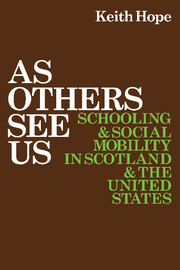Book contents
- Frontmatter
- Contents
- Acknowledgments
- Introduction
- 1 Scotland: A meritelective system?
- 2 Comparison of Scotland with England and Wales
- 3 Comparison of Scotland with the United States
- 4 IQ + effort = merit
- 5 The institutions of managed meritelection
- 6 Was selection carried out fairly?
- 7 Meanings of key terms
- 8 Does deprivation affect life chances?
- 9 Market situation
- 10 Intelligence and occupational mobility
- 11 Intelligence and vertical mobility
- 12 Scottish society
- 13 Understanding other people's norms
- 14 Merit or desert?
- Notes
- References
- Index
10 - Intelligence and occupational mobility
Published online by Cambridge University Press: 05 February 2012
- Frontmatter
- Contents
- Acknowledgments
- Introduction
- 1 Scotland: A meritelective system?
- 2 Comparison of Scotland with England and Wales
- 3 Comparison of Scotland with the United States
- 4 IQ + effort = merit
- 5 The institutions of managed meritelection
- 6 Was selection carried out fairly?
- 7 Meanings of key terms
- 8 Does deprivation affect life chances?
- 9 Market situation
- 10 Intelligence and occupational mobility
- 11 Intelligence and vertical mobility
- 12 Scottish society
- 13 Understanding other people's norms
- 14 Merit or desert?
- Notes
- References
- Index
Summary
In this chapter we leave the attempt to define class position in terms of market situation and revert to a traditional scheme of analysis – namely, the ordinary table of intergenerational occupational mobility. In our case this is the table obtained by cross classifying the nine occupational categories of fathers and the nine occupational categories of sons. The intergenerational table is given in Table 10.1. It may be compared with the table computed from the same data and reported by Maxwell (1969, table 18) which was analyzed by Hope (1972a). There are, in fact, a few minor discrepancies: Maxwell's table and the one reported here differ by one father-son pair in each of fourteen cells. The discrepancies make no difference to the interpretation of the analysis.
In this and the following chapter, we will employ two closely related techniques for the analysis of the table of intergenerational mobility. The first technique is the method of canonical contingency analysis, and the second is the method of log-linear analysis. Both techniques typically start with an assumption of statistical independence of rows and columns. When applied to the analysis of mobility, this assumption is called the perfect mobility hypothesis. What it says is that the probability of a son lying in column j of the mobility table is the same for fathers in row 1, fathers in row 2, and so on down to the last row, and that this holds for every column.
- Type
- Chapter
- Information
- As Others See UsSchooling and Social Mobility in Scotland and the United States, pp. 181 - 201Publisher: Cambridge University PressPrint publication year: 1985



